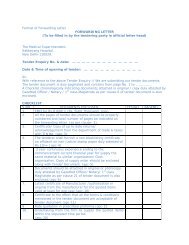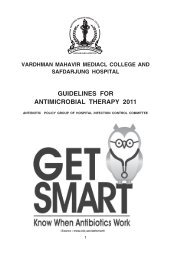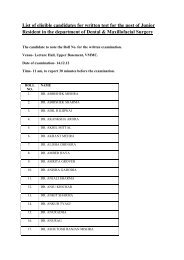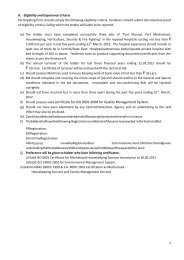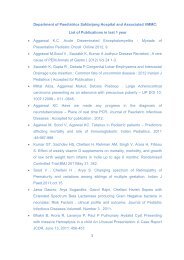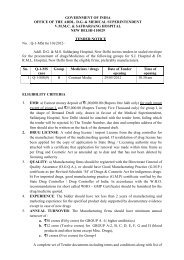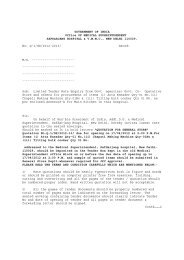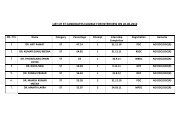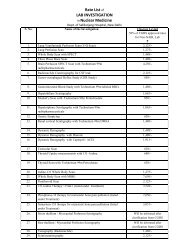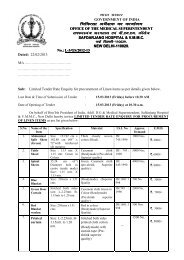Guidelines for INFECTION CONTROL POLICY - Safdarjung Hospital
Guidelines for INFECTION CONTROL POLICY - Safdarjung Hospital
Guidelines for INFECTION CONTROL POLICY - Safdarjung Hospital
Create successful ePaper yourself
Turn your PDF publications into a flip-book with our unique Google optimized e-Paper software.
• The isolation of the patient would be done taking following into consideration:(1) Separate ward/room/area is designated <strong>for</strong> keeping the patient.(2) Isolation wards/area has double door entry with a separate changing room withavailability of Personal Protective Equipment (PPE) and disinfectants and a handwashing area providing negative pressure with adequate air changes (6-12/hour) andHEPA filtered air in case of patients suffering from respiratory pathogens.(3) Central air conditioning and use of desert air coolers is not permitted.(4) Adequate distancing between patient beds (3-6 feet) to be ensured.(5) Overcrowding to be avoided in isolation ward/area.(6) Unauthorised Visitor’s entry is to be prohibited.(7) Nobody is allowed to enter the ward without donning adequate PPE.(8) As far as possible dedicated health care staff to be posted <strong>for</strong> isolation ward.(9) Regular daily cleaning and proper disinfection of isolation wards to be done at leasttwice a day. in addition, special attention should be given to cleaning and disinfectingfrequently touched surfaces to prevent aerosolisation. Damp sweeping/wet moppingto be per<strong>for</strong>med.(10) Standard precautions which include barrier nursing to be followed with special stresson hand hygiene using soap water and alcoholic hand rubs (Preferably foot operated)and the procedures should be adequately displayed <strong>for</strong> the same.(11) Appropriate use of PPE should be strictly adhered to e.g. use of face masks,N95 masks, gloves, gowns, aprons , shoe covers, head covers etc as per therequirement (The procedures of donning/undonning of PPE will be displayed).(12) Sharing of equipments among the patients to be avoided, if unavoidable, ensure thatreusable equipments are disinfected be<strong>for</strong>e use on other subjects(Equipments likeThermometer, Nebulisers ,Stethoscopes, BP apparatus cuff to be dedicated <strong>for</strong> eachpatient).(13) All the equipments coming in contact with the patient should be disinfected.(14) Use of mobile phones by healthcare staff to be avoided inside the isolation area.(15) Appropriate waste disposal facilities to be available in the isolation area, All wasteto be treated as infectious and should be segregated and disinfected be<strong>for</strong>e removalfrom the isolation area.(16) All paper work/record keeping should be done outside the isolation area.(17) Sample collection to be done using appropriate PPE, following standard work precautions.Sample to be packaged/transported in triple packaging.(18) Used linen to be handled as little as possible with minimum agitation and should betransported in closed containers and should be labelled as infectious be<strong>for</strong>e sendingto laundry <strong>for</strong> washing.(19) Regular training on PPE, standard precautions and other infection control <strong>for</strong> thehealthcare workers and providers shall be under taken.INVESTIGATION OF AN OUTBREAKThe occurrence of two or more similar cases relating to place and time is identified as a clusteror an outbreak and needs investigation to discover the route of transmission of infection, andpossible sources of infection in order to apply measures to prevent further spread. If the casesoccur in steadily increasing numbers and are separated by an interval approximating theincubation period, the spread of the disease is probably due to person to person spread. Onthe other hand if a large number of cases occur following a shared exposure e.g. an operation,it is termed a common source outbreak, implying a common source <strong>for</strong> the occurrence of thedisease.13



